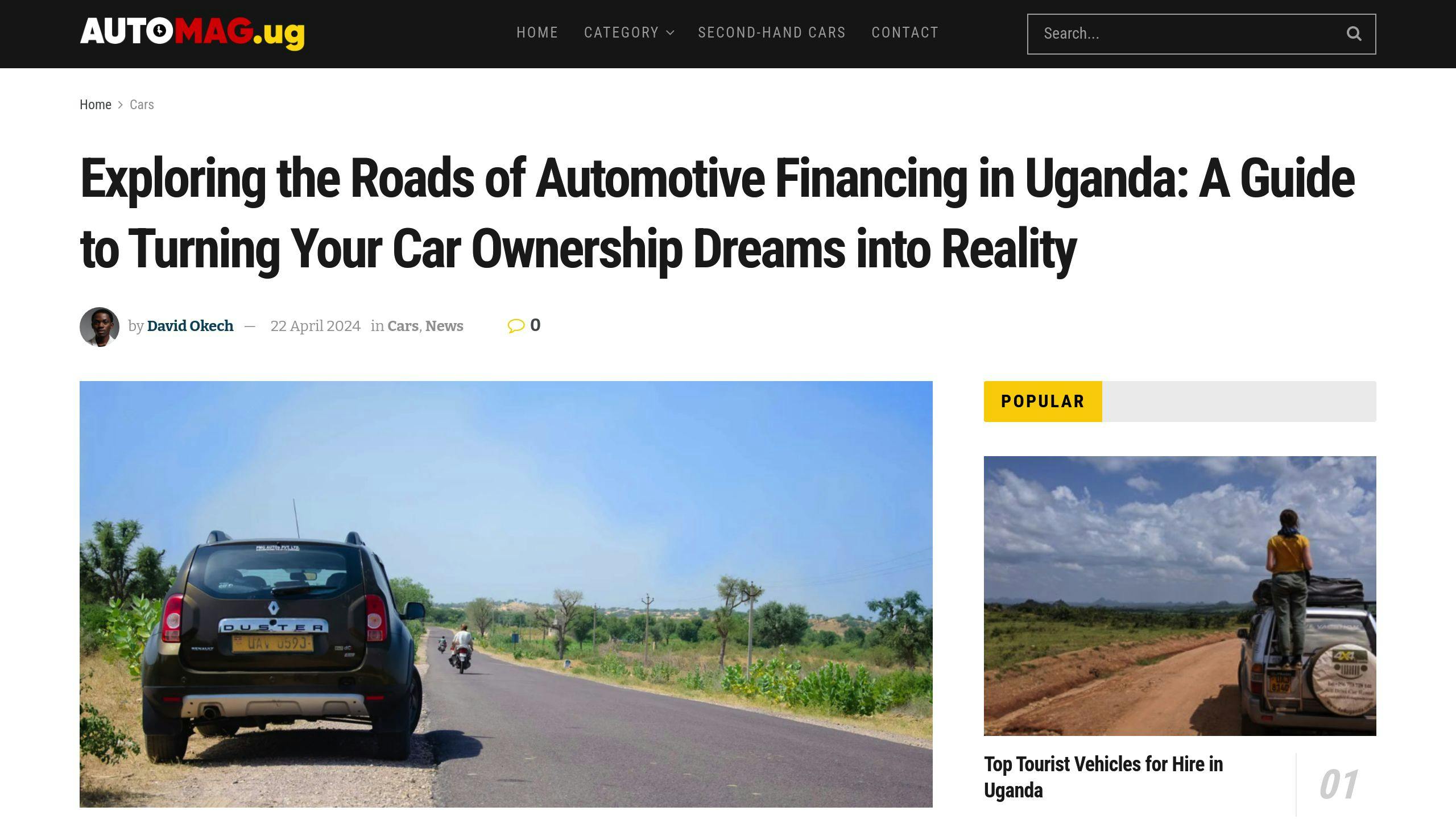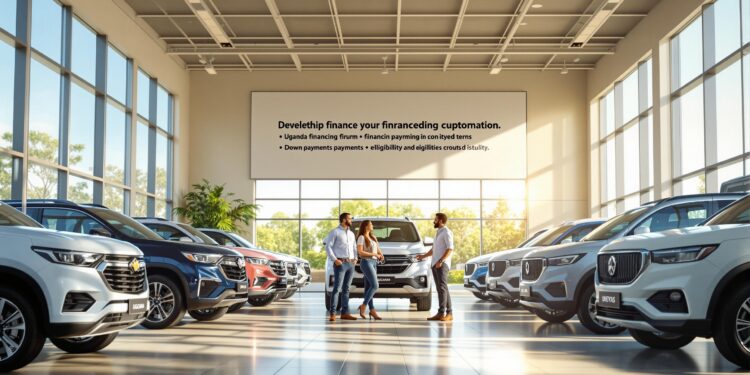Dealership financing in Uganda lets you buy a car and arrange a loan in one place, thanks to partnerships between dealerships, banks, and insurance companies. Here’s what you need to know:
- Down Payments: Typically 10-30% of the car’s price.
- Loan Terms: 12 to 60 months, with interest rates between 15-25%.
- Eligibility: Proof of stable income (UGX 1.5M+ per month), good credit, and required documents like bank statements and ID.
- Approval Time: Applications are processed in 24-48 hours if documents are complete.
Quick Tip: To get better terms, negotiate separately for the car price and financing, and aim for a down payment of 25-30%.
This guide covers everything from eligibility, loan terms, and application steps to tips for better deals. Let’s dive in!
How to Get a Car Loan
Eligibility for Dealership Financing
To secure dealership financing in Uganda, you must meet specific criteria that demonstrate your financial stability and ability to repay.
Income and Employment
Dealerships require proof of consistent income and employment. Here’s what they typically look for:
- A monthly income of UGX 1,500,000 to 2,000,000 for entry-level vehicles, or UGX 5,000,000+ for higher-end options.
- At least 6-12 months of current employment for salaried individuals or 2-3 years of business operation for self-employed applicants.
- Debt obligations that don’t exceed 50% of your monthly income.
Credit and Financial Stability
Beyond income, lenders evaluate your financial history to assess reliability. Here’s how they do it:
| Key Factors | Verification Methods |
|---|---|
| Banking History | Analysis of 6-12 months of bank statements. |
| Existing Loans | Review of payment records for current loans. |
| Financial Health | Examination of your assets and liabilities. |
| Credit Bureau Check | Search for negative records with the Credit Reference Bureau. |
| Income Stability | Evaluation of consistent income patterns. |
If you’re self-employed, dealerships may also ask for business registration documents and tax compliance records to confirm your financial stability.
Required Documents
Having the right paperwork ready can speed up your financing application. Here’s what you’ll need:
-
Personal Identification
- A valid government-issued ID or passport
- Tax Identification Number (TIN) certificate
- Proof of residence, such as a recent utility bill
-
Financial Documentation
- Bank statements covering 6-12 months
- Payslips for the last 3-6 months
- Proof of current employment
-
Business Documents (for self-employed applicants)
- Business registration certificate
- Tax compliance records
- Financial statements
Most dealerships process applications within 24-48 hours if all documents are in order. Once you’ve gathered everything, you’re ready to move on to the application process, as detailed in the next section.
Applying for Dealership Financing
Choosing a Vehicle
Start by figuring out how much you can afford to pay each month. Factor in your income and any current financial responsibilities. Make sure your budget fits the dealership’s criteria before moving forward with the application process.
Application Submission
Once you’ve chosen a vehicle and confirmed your budget, gather the necessary documents (mentioned in the Eligibility section) and submit them to the dealership. These will be forwarded to the bank for evaluation.
Credit Check and Approval
The bank will evaluate your finances based on the following:
- Your debt-to-income ratio, which should stay below 50%.
- A review of your bank statements to ensure steady income.
- Examination of any existing loans you may have.
- An overall look at your financial stability.
The approval process typically takes a few days:
- Application review: 1-2 days
- Financial assessment: 2-3 days
- Final decision: 1-2 days
If your application is approved, you’ll receive a loan offer outlining the interest rate, loan term, and monthly payment. Be sure to carefully review the terms before agreeing to the offer.
sbb-itb-7bab64a
Terms and Conditions of Financing
Interest Rates and Loan Terms
In Uganda, dealership financing interest rates typically range between 15% and 25%, depending on your credit profile. New vehicles often come with lower rates (15–20%), while used vehicles may have higher rates (20–25%).
Loan terms usually vary from 12 to 60 months, with 36 months being the most common. Knowing these terms can help you evaluate and choose the best financing option.
Here’s a breakdown of total costs on a 20M UGX loan at 20% interest:
| Loan Term | Monthly Payment | Total Interest Paid |
|---|---|---|
| 24 months | 1,033,000 UGX | 4,792,000 UGX |
| 36 months | 744,000 UGX | 6,784,000 UGX |
| 48 months | 605,000 UGX | 9,040,000 UGX |
Down Payment
The down payment required depends on the type of vehicle and your credit standing:
- New vehicles: 10–20% of the purchase price
- Used vehicles: 20–30% of the purchase price
- Luxury vehicles: 30% or more
- Good credit: As low as 5–10%
- Poor credit: Could be as high as 40%
For example, if you’re buying a 50M UGX SUV, you may only need to pay 5–10M UGX down if you have good credit.
Repayment Plans
Dealerships in Uganda provide several repayment options to suit different financial needs:
- Monthly Payments: Fixed payment dates with straightforward terms.
- Bi-weekly Payments: 26 payments per year instead of 12, which may help lower overall interest costs.
"CFAO’s financing options are flexible and transparent, allowing customers to compare offers from different banking partners."
Common Fees
When financing a vehicle, expect to encounter these fees:
- Processing Fee: 1–2% of the loan amount
- Stamp Duty: 1%
- Legal Fees: 200,000 UGX
- Late Payment Fees: 5–10% after a 5–7 day grace period
Keep in mind, missing three payments in a row can result in repossession of the vehicle.
Tips for Better Financing Deals
Negotiating with Dealerships
When dealing with dealerships, timing can make a big difference. Visiting near the end of the month or quarter often works in your favor, as sales teams are eager to hit their targets. As Stanbic Bank Uganda financial experts explain: "Understanding the total cost of ownership, not just the purchase price, is crucial when financing a vehicle in Uganda."
To improve your negotiating power:
- Get pre-approved for financing (with rates around 15-17%) before visiting.
- Offer a down payment of 25-30% to improve your terms.
- Separate the vehicle price negotiation from the financing discussion – this helps you focus on each aspect clearly.
Understanding Terms
Once you’ve negotiated, carefully review these key parts of your financing agreement:
| Term Component | What to Check | Why It Matters |
|---|---|---|
| APR | Compare with market rates (17-25%) | Impacts the total interest you’ll pay. |
| Loan Duration | Aim for 12-36 months | Longer terms mean paying more in interest. |
| Processing Fees | Keep it within 1-2% | Affects your upfront costs. |
| Prepayment Terms | Look for penalties | Flexibility to pay off early is important. |
| Insurance Requirements | Ensure comprehensive coverage | Most lenders require this. |
Hidden charges, like arrangement fees (usually 1-2% of the loan amount in Uganda), can catch you off guard. Always ask for a detailed breakdown of all costs in writing to avoid surprises.
Avoiding Mistakes
Even with a solid strategy, it’s easy to make missteps. Here are three common pitfalls to steer clear of:
1. Extended Loan Terms
Loans longer than 60 months may seem appealing due to lower monthly payments, but you’ll end up paying significantly more in interest over time.
2. Bundled Add-ons
Extras like extended warranties or gap insurance can inflate your loan amount. Only agree to these if they’re truly necessary.
3. Rushing the Process
Take your time reviewing all documents. Research shows that buyers who spend at least 48 hours comparing offers often secure interest rates 2-3% lower than those who don’t shop around.
Conclusion
Key Takeaways
Financing a vehicle through dealerships in Uganda simplifies the buying process by connecting dealerships with financial institutions. Typically, buyers need to make a down payment of 10-30% of the car’s value.
As highlighted in the Terms and Conditions, important details include:
- Interest rates ranging from 17-25%
- Loan terms spanning 12-60 months
- Comprehensive insurance as a requirement
To qualify, you’ll need proof of stable income and a solid credit history.
How AutoMag.ug Can Help

AutoMag.ug provides tools to make the financing process easier, such as:
- Comparing rates from multiple dealerships instantly
- Using pre-approval calculators to estimate your options
- Creating a document checklist to stay organized
"Understanding the total cost of ownership, not just the purchase price, is crucial when financing a vehicle in Uganda", says Stanbic Bank Uganda’s financial experts.
FAQs
Can I pay for a car in installments in Uganda?
Yes, installment plans are available for purchasing cars in Uganda. Here’s how they typically work:
For new cars:
- Financing covers up to 90% of the car’s cost.
- Repayment periods can extend up to 5 years.
- Down payments are generally lower, around 10%.
For used cars:
- Financing covers up to 80% of the car’s cost.
- Repayment periods are capped at 4 years.
- Down payments are higher, typically around 20%.
These plans follow the credit evaluation and documentation process mentioned earlier. As you pay off the principal, the interest also reduces over time.
When buying through certified dealership partners, you’ll need to account for these additional fees:
| Fee Type | Typical Cost |
|---|---|
| Insurance | Comprehensive coverage is required |
| Registration | Depends on the engine size |
| GPS Tracking | If deemed necessary |
Related Blog Posts
- Used Car Inspection: 10-Point Checklist Before Buying
- Common Car Problems in Uganda: Solutions Guide
- How to Save Money on Used Car Maintenance
- Uganda’s Localization Policies in Automotive Manufacturing




